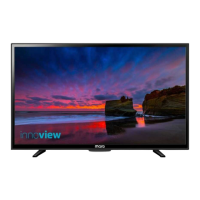
Do you have a question about the Flipkart Marq Innoview 32DSHD and is the answer not in the manual?
| Screen Size | 32 inches |
|---|---|
| Resolution | 1366 x 768 pixels |
| Display Type | LED |
| Smart TV | Yes |
| HDMI Ports | 2 |
| USB Ports | 2 |
| Audio Output | 20 W |
| Wi-Fi | Yes |
| Bluetooth | Yes |
| Refresh Rate | 60 Hz |
| Operating System | Android |
| RAM | 1 GB |
| Internal Storage | 8 GB |
| Speaker Type | Built-in |
Explains product's qualification for BEE Star rating and energy efficiency implications.
General safety advice for reliable and safe operation of the equipment.
Guidelines for safe electrical connections, usage, and physical handling.
Information on responsible disposal of electronic waste according to regulations.
Essential safety guidelines covering water, cleaning, ventilation, heat sources, plugs, and power cords.
Instructions on approved accessories, storm unplugging, servicing, and avoiding heat.
Notes on USB load, mounting height, flicker, dot defects, and screen care.
Warnings about overloading outlets and protecting the power cord during use.
Product compliance with E-WASTE MANAGEMENT RULES, 2016, and RoHS declaration.
Guidelines for proper disposal of electronic products and batteries.
Website and toll-free number for Extended Producer Responsibility.
List of items included with the LED TV; contact dealer if missing.
Step-by-step guide for assembling the TV's base stand.
Placing TV face down, preventing scratches, and fixing adapters to the TV.
Installing the wall bracket securely and mounting the TV onto it.
Adjusting TV for horizontal leveling and centering on the wall.
Disconnecting cables, placing TV, fixing stand, and using correct screws.
Proper placement on a firm surface, avoiding water/heat, and maintaining ventilation.
Connect the antenna cable to the antenna socket on the TV's back.
Plug the TV's power cord into a suitable power outlet.
How to turn on the TV using the backside button or remote control.
Connecting external devices like DVD players or PCs and selecting input source.
Connecting devices to the TV's AV 1 IN and multimedia terminals.
Connecting devices to the TV's AV 2 IN (MINI) and multimedia terminals.
How AV cables are color-coded for correct connection.
Connecting a PC and outputting AV signal to external devices.
Connecting multimedia devices via HDMI and headphones to the TV.
Connecting USB storage devices to the TV's USB ports.
Connecting the 75 OHM coaxial cable from the antenna to the TV.
Information on VHF/UHF antennas and necessary adapters (300 OHM/75 OHM).
Location and function of physical buttons on the back-right side of the TV.
Description of each physical button (Power, Source, Menu, Vol+/-, CH+/-).
How to connect the AC power cord and switch the TV on/off.
Guidelines for optimal remote control distance and angle.
Inserting batteries and pointing the remote at the sensor.
Overview of buttons on the remote control.
Factors affecting sensor performance and effective operation distance.
When to replace weak batteries and general battery handling precautions.
Detailed functions of specific remote control buttons (Power, Mute).
Selecting channels using number buttons and navigating menus with arrow keys.
Functions of FREEZE, DISPLAY, ZOOM, P.MODE, S.MODE, CH+/-, VOL+/-.
How to display and select input sources using the SOURCE button.
Functions of ENTER, MENU, and EXIT buttons for menu control.
Managing favorite channels using FAV/LIST and FAV+ buttons.
Displaying channel list and editing channels using colored buttons.
How to display, navigate, and interact with main and sub-menus.
How to perform Auto Tuning and ATV Manual Tuning for channels.
Adjusting Current CH, Colour System, Sound System, Fine-Tune, AFC, and Search.
Deleting, renaming, moving, and skipping channels within the programme edit menu.
Adding or deleting channels to/from the favorite list.
Notes that picture options may vary based on signal sources.
Choosing picture modes and adjusting contrast, brightness, color, tint, sharpness, and temperature.
Clearing input signal noise and selecting desired sound modes.
Adjusting audio balance, auto volume, surround sound, and audio output.
Setting the internal clock and configuring auto turn-off timers.
Setting timers for TV shut-off and OSD display duration.
Setting OSD language, aspect ratio, blue screen, and locking control panel keys.
Available aspect ratio modes for different input sources (TV, AV, VGA, HDMI, USB).
Enabling Hotel Mode, source lock, password, volume, and channel controls.
Adjusting screen parameters like auto adjust, position, clock, and phase for PC input.
Inserting USB devices and selecting media source for playback.
Navigating media files and folders using menu controls.
Accessing menu options while playing media files.
Copying files between USB1 and USB2 ports using the remote's copy function.
Functions for play/pause, fast forward/backward, and previous page.
Functions for play next, stop, repeat mode, background music, and playlist view.
Rotating images, adjusting picture size, muting audio, and selecting playing time.
Setting A-B repeat points for specific playback segments.
Model, screen size, aspect ratio, power supply, and consumption details.
TV system compatibility and audio output power specifications.
List of available input and output terminals (Antenna, PC, HDMI, USB, etc.).
Supported RGB signal input resolutions and frequencies.
Physical dimensions, box dimensions, and operating environment ranges.
Supported file systems and maximum HDD capacity for USB.
Notes on potential changes to specifications and file compatibility.
Avoiding fixed images for long periods and understanding normal pixel behavior.
Steps to resolve issues with power, sound, and remote control not responding.
Resolving screen flickering, VGA interference, and abnormal colors.
Guidance on how to safely clean the TV set.
Details on warranty coverage, period, validity conditions, and exclusions.
Damages due to accidents, misuse, and items like accessories not covered.
Information on chargeable services after warranty expiry and service timeliness.
Conditions that void the warranty and how the warranty period expires.
Customer indemnity clauses and limitations on company liability for damages.
Contact details for customer redressal and assistance.